art | architecture | design | digital | gallery | music | painting | photography | sculpture | video
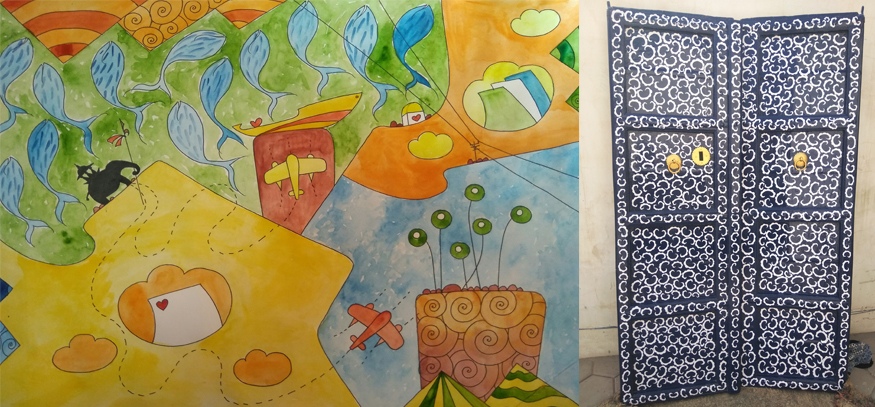
It's myself art journey. Last 10 years to continue I am busy in myself search through the art and painting. For me painting is a language. It's need vision not any kind of texts ...
read more »
submission date: 1/21/2019
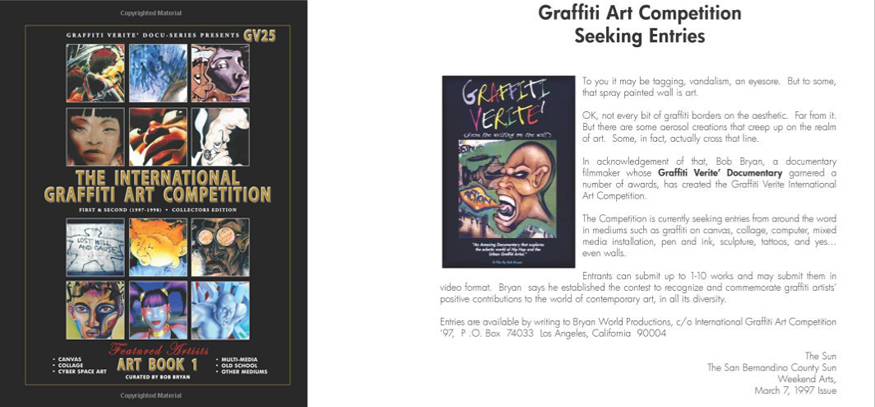
In 1997 and 1998 Filmmaker Bob Bryan singlehandedly created, produced & curated the "1st and 2nd International Graffiti Art Competition." This was a first ever event, celebrating Art creations from Spray-Can Artists all around the world. The IGAC took place in the downtown Museum of Art, Los Angeles California. This beautiful & impressive Collectors Edition (ART BOOK 1 & ART BOOK 2) commemorates the vast style diversity of the International submissions and winners. ART BOOK 1 CATEGORIES: ¨ Canvas ¨ Collage ¨ Cyber-Space Art ¨ Multi-Media Installation ¨ Old School ¨ Other Mediums THE GENESIS of GRAFFITI VERITE’: Read the Writing on the Wall "Truth Or Dare" (Featured Article in RAP PAGES MAGAZINE) Graffiti Verite’s Bob Bryan continue to prove that beauty is in the eye of the beholder GRAFFITI VERITE’, the incisive documentary on the lives of Los Angeles Graffiti Artists, blew up like no other graff video to date, leaving behind an unprecedented trail of award recognition, media exposure and education about the Art Form. Bob Bryan, director, producer and director of photography on the film, accomplished what no other videographer had yet been able to do: create a graffiti documentary with mainstream crossover appeal. “I managed to promote the documentary in a way that didn’t just reach some of the old heads that were already in the life, but ‘turn-on’ people that didn’t know anything about Graffiti Art or that had a prejudice against graffiti,” Bryan points out. The filmmaker particularly targeted gallery people, educators, librarians and institutions that could be an asset for Hip-Hop and Graffiti Art in a financial sense. Bryan’s aesthetic and technical skills have been acknowledged with film and video competitions worldwide, including the prestigious Council of Int’l Non-Theatrical Events (CINE) Golden Eagle Awards, as well as, a National Educational Media Network, GOLDEN APPLE Award, Cinema in Industry (CINDY) Awards (sponsored by the Association of Visual Communicators (AVC) - not to mention that he’s also up for an Emmy this year. This year also finds Bryan taking it to another level by legitimizing Graffiti Art on an international scale through the creation of the First Annual International Graffiti Art Competition. “I’m taking the credibility that GRAFFITI VERITE’ has established and bringing a lot of Graffiti Art to the attention of major institutions and educational organizations,” he says. “I’ve been successful with being able to bring Los Angeles Graffiti Artists up, and now what I want to do is bring the international community of Hip-Hop and Graffiti Art to the attention of a worldwide audience.” Bryan’s sole purpose for the establishment of the FIRST INTERNATIONAL GRAFFITI ART COMPETITION is to “...create a forum for the serious examination, illumination, appreciation and recognition of this worldwide Art Form and phenomenon...”
-- By Ben Higa, RAP PAGES
read more @ amazon »
submission date: 6/13/2014
Graffiti Verite' 25 (GV25) The International Graffiti Art Competition-Art Book 1: First & Second (1997-1998) - Collectors Edition (Graffiti Verite' Docu-Series) (Volume 25) Paperback – June 1, 2015
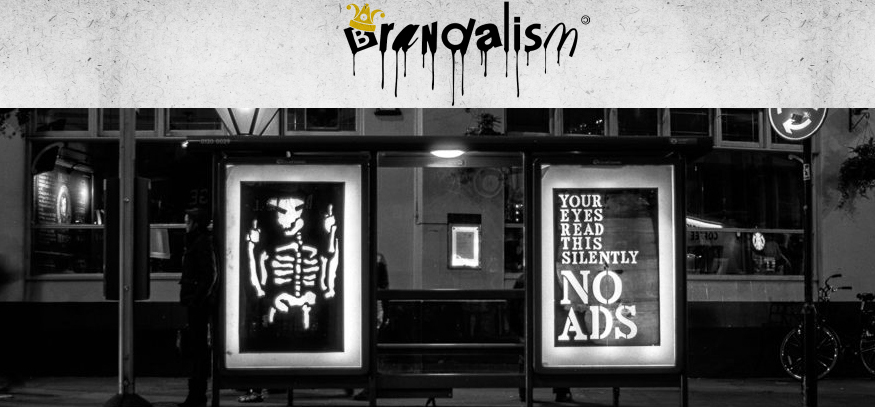
* 360 original artworks by 38 international artists replace adverts by major corporates such as McDonalds, CocaCola, H&M and Morrisons
* Millbank, Department of Business and Innovation, Scotland Yard, Harrods, Oxford Street and Shell Centre in London targeted.
* Entire route of Leeds marathon covered with anti-advertising artworks
* Themes include austerity, human rights, debt, climate change, body image and fracking
This weekend has seen the biggest ever unauthorised takeover of outdoor advertising, as part of the rapidly growing “Brandalism” campaign against what activists have called the corporate take-over of public space. Around 360 adverts in 10 cities across the UK were replaced overnight with specially commissioned artworks by teams of anti-advertising activists.
'Six-sheet' poster displays at bus-stops, free standing cabinets and even a public toilet were taken down in Glasgow, Edinburgh, Leeds, Liverpool, Brighton, Bristol, Birmingham, London, Oxford and Manchester. The adverts - by companies such as H&M, CocaCola, Fanta, McDonalds, Morrisons and Lyca Mobile - were replaced with artworks exploring the impacts of consumerism, including ecological damage, financial collapse, and gender stereotypes. With the United Nations currently investigating the impact of advertising on human rights [ 1 ], Brandalism seeks to highlight the lack of control that communities have over their public space.
38 international artists participated in the latest round of Brandalism takeovers including Peter Kennard, Paul Insect, Bill Posters, Goldpeg and Radiohead’s artist of choice Stanley Donwood (UK), Princess Hejab (France), Ron English (USA), Peter Fuss (Poland) and Anthony Lister (Australia).
Brandalism first launched in July 2012, when around 40 billboards in five cities were replaced with anti-advertising artworks. Since then the Brandalism project has grown in ambition and scale.
The Brandalism website will show people how they can replicate this type of action in their localities.
Bill Posters, one of the artists involved in Brandalism, said:
“This is a revolt against visual pollution. Advertising is key driver of a system which destroys our future to fulfil the demands of the present, a ceaseless expansion of production and consumption. Communities are taking back control over their public spaces - expect many more actions like this in the near future.”
largest advertising takeover in world history (as far as we can tell).
365 public ads were access replaced with art from 38 international artists including Peter Kennard, Paul Insect, Bill Posters, Goldpeg and Radiohead’s artist of choice Stanley Donwood (UK), Princess Hijab (France), Ron English (USA), Peter Fuss (Poland) and Anthony Lister (Australia).
Brandalism is a revolt against corporate control of the visual realm. It is the biggest anti-advertising campaign in world history and it's getting bigger. Starting in July 2012 with a small team in a van, Brandalism has grown tenfold to include teams in 10 UK cities skilled up in taking back space. The most recent Brandalism Takeover in May 2014 saw the reclamation of over 360 corporate advertising spaces with hand made original art works submitted by 40 international artists. Following on in the guerilla art traditions of the 20th Century and taking inspiration from Agitprop, Situationist and Street Art movements, the Brandalism project sees artists from around the world collaborate to challenge the authority and legitimacy of commercial images within public space and within our culture.
Brandalism has worked with 16 teams of citizens who have been trained in the techniques and tactics of 'subvertising' - the art of subverting advertisements; before heading out onto the streets of the UK’s major cities for two days of redecoration. In Liverpool, Glasgow, Edinburgh, Manchester, Leeds, Oxford, London, Brighton, Bristol, and Birmingham the team mounted artworks which they had screen-printed themselves, disguised as outdoor advertising installers.
Brandalism starts from the democratic conviction that the street is a site of communication, which belongs to the citizens and communities who live there. It is a rebellion against the visual assault of media giants and advertising moguls who have a stranglehold over messages and meaning in our public spaces, through which they force-feed us with images and messages to keep us insecure, unhappy, and shopping.
All the artwork is unauthorised and unsigned. This is not a project of self-promotion, and none of the artists names (we forgive you Ludo!) or websites appear on the works: we believe there are already enough private interests taking ownership of our streets.
In Liverpool, Glasgow, Edinburgh, Manchester, Leeds, Oxford, London, Brighton, Bristol, and Birmingham, adverts have been replaced over two days with images from artists around the world made especially for the event. Themes explored include the ecological damage of consumerism, debt, gender stereotypes, the right to the city, the disaster of finance capitalism, and the pervasiveness of advertising itself.
The first Brandalism Takeover took place in July 2012. Two friends, sick of the visual pollution of their city, spent 5 days reclaiming 36 billboards in five cities around the UK. Overwhelmed by the positive response from people across the country, we decided to train up other people to do the same thing themselves. Two years later, groups across the country are now taking action in their local areas to reclaim public space from the claws of corporate interests. More Takeovers are expected in the near future.
Brandalism provides resources and support for anyone who wants to reclaim their visual space. Check out the resources page, and get in touch through brandalism@riseup.net
www.brandalism.org.uk
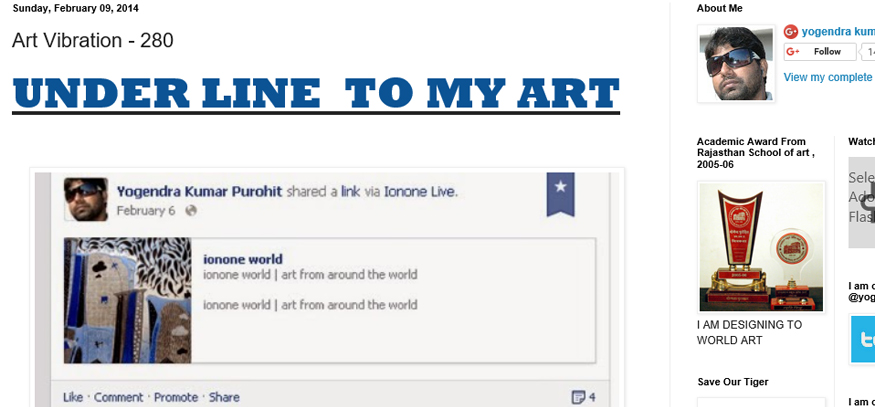
Friend someone working in our world for positive work by way of promotion to others . it is a very good thing or today it is very must for creation of peace and love in our world . we know some societies and NGO of our world are working in this way for promotion of true work of our world .
We know our contemporary communication way is online communication by this way we are connecting to our world in very short time . today its have a identity and we are calling to it web world . mostly all world is connect to this medium of communication for express or promotion . it is working in all sector of life , it is promoting and expressing to education, art, science ,business , or all subject of our life . people can get his or her interest level subject on this web world . it is a good way for positive action or that’s success.
Last six years to I am connect to this online communication web world as a art master. I have registered myself on this web world as a visual art master , on this way I have expressed my inner art sound and I have promoted to others art sound as a art master time to time. Because it is my art duty for our world art family .
On this way someone are observing continue to my art work and they are giving me space by promotional sound of them in this web world . I know in 2008 I were connected to a online magazine that’s name is www.ionone.com , when I were connected to this online magazine I were shared my first blog post ( Art Vibration-1 ) of this art vibration . they were observed to my true art sound in wrong English words .
Today 2014 they are connected to me and in this six years they were many time promoted to my art by this online magazine in our web world. I can say they have underline to my art.
Last week once again I saw a update from www.ionone.com on facebook.com they have shared a link with title Art From Around The World , in that update link I saw they have selected my art painting of MYSELF. I were shared that art painting image, in year 2008 with www.ionone.com . they have not forgot my true art work or that’s true art sound . after 2008 I have shared many other art work visuals with www.ionone.com but they have shared that first painting of myself like a underline work.
Here I am going to share that update link of www.ionone.com or a image of that update. I were collected that image from page of facebook.com. http://www.ionone.com/world.htm
in my heart I am once again thankful for team of online magazine www.ionone.com. they are noticing my art expressions or art visuals on online and time to time they are promoting to my art sound by web magazine of www.ionone.com . it is a big achievement for me because my art in underline of a world level online art magazine .
I hope this online art magazine will give me more art energy by right art promotion of myself art sound in front side of our world art family and I am promising to this online magazine or that’s team I will live busy in art continue just like past because I want to create love and peace in our world by way of art just like your team of www.ionone.com .
I am happy someone are working and thinking just like me in ourworld art family so I am with them as a art master of visuals art. I am happy they have underline to me or my art work .
so I said here underline to my art …
read more »
Yogendra Kumar Purohit
Master of Fine Art
Bikaner, INDIA
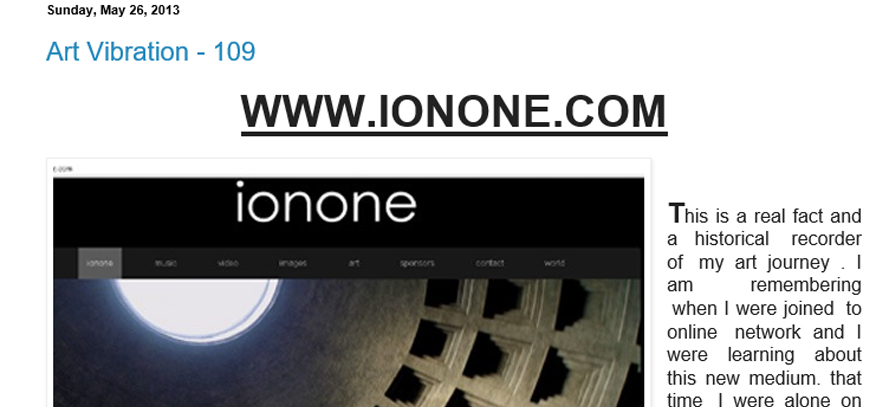
This is a real fact and a historical recorder of my art journey . I am remembering when I were joined to online network and I were learning about this new medium. that time I were alone on online , no one for guide line and no one for help to me for my art communication . In that movement I were wrote a very first note on my art work of Myself . that was in 500 something words in English in that note I were wrote perfect impression of my heart and mind but my English was not perfect .
When I were wrote that note then I were started search for share to that art note for world art family. Because by mail process that was very complicated for me so I were found a blog space by google network . I were created my own blog by support of google .com, did I gave name to that first art post Art Vibration . but that time I were not knew one day this blog link will really vibrate to world art family by sound of my true art . after google blog post . I got a short link for share with all on online. i did shared that link to 5000 something web page of our world art family by online network . some one reply or some one not but i were busy in sharing work of my first blog post with our world art family continue . that was open challenge for me and i were completed that . here I want to share with you that first blog post link for your notice. http://yogendra-art.blogspot.in/2008/07/art-vibration.html it was published on blog in year 2008 .
In 2008 I were very busy in communication and in search of art web site links because in that movement I were not connected to any online network and I did not knew much more knowledge about online use, so I were working with safe mode , I think that was must for me and I were lived with that mode . one day I were found a website link that was world wide art web site . I got that web page mail id and sent my blog post link with a short information about my art journey . after a one week I were received a reply by that web site owner . the Director of That Web Site was wrote in that mail yogendra we have published your art work image and your art note on our web site blog so you can visit our web page link ionone.com , I were got happy because first time a international online web site was selected my art work and they were published my work with title of PAINTING OF INDIA. When I saw that page then I were felt proud on myslef because my art work was representing to my nation Name with my art sound . that day I were knew the real definition or meaning of online and I were knew my real duty on this online network , because on this network we are representing to our nation with our self vision so it was very responsible job for me, after that first online art publication . that was my first online art relation , it was started by this online network tool . I were noticed its fast result and impressive effect for true art.
After 2008, I am continue in touch of ionone.com and they are watching my art journey as a true art critic or as a art promoter . it's a natural art fact of my art journey. In 2010 I were connected to ionone web site page on facebook . on facebook I were visited lots of art concept and I observed idea of ionone for true art promotion . in this time they have been shared my many art visuals for world art family by ionone.com facebook page . that was a real art promotional work from ionone .com team about my art journey. So I am thankful for them .
IN this month Before two week I were completed my 1000 drawing on concept of Myself . that concept starting work image was published by ionone.com site in 2008 . After 1000 drawing work I were shared a post on this art vibration blog and that's link I were shared with ionone.com by luck last week they were visited and noticed to my blog post and my art energy or that's result . after that they have added my blog link on main page of ionone.com with my full name . It was a true reward to my art journey by team of ionone.com. international online art promoters .
This post is just a thanks to director or team of ionone.com and a special art news for my online world art family . because I have found a right art promoter in this true art journey in year 2008 and that day to till today a one international art observer is walking and moving with me on this international online art communication path .we were not meet live and face to face but our art sense is connected with deep feeling relation and its mixed in our daily art life just like water and fresh air .. so I am saying www.ionone.com
read more »
My art vision Base is Myself..i think every human being live for self and its fact of human life. So i have start from basic of life through my art vision, I am master in painting and last 15th years to continue i am doing art work, like a painting, Design, Sculptures, Installation, Craft, Drawing, Sketching, Art movie and conceptual art work and this visual you can visit at www.yogendra-art.page.tl, then you can understand my art vision and my talking way about my art. I think art is a journey and its end with artist death.. The last point of the art journey is artist death. i know it, because i have lots of example in art history just like that, the artist Vinsent Wongong, Sezaan, Picaso, Kurbe, Michelangelo, Jamini Roy, Amrta Sergill, Liyonardo the vinchi and lots of artist in our world art.i can't write all Artist name so sorry.. The painting mean for me.. The painting is a very strong way for catch the self of artist and painting giving way of live peace full life journey with colour, with love, with feeling,with nuture, with self for others. In painting not importent if how to you painting it and what you paint it but its very importent why artist paint a painting, what he want from canvas,colours,forms and from his self.. its exapmple is Vincent Vangogn.. He Had paint a paint my shoe.that time vincent was very alone and he was feel very unfit. that time he saw his shoe and thought it, My shoe care my feet when , that time i was walk alone on the road..its mean he want to say thanks to his shoe because he feel the shoe care and support to vincent in alone time.so i want to say every artist live his art life and then he think somthing and then they paint, i can say ,i am also on this track from my art Vision .. as a painter ... as a master of art...art is giving a new way to stop life in every time and in any condition of human life,,art have power of life base..art have vision,, art giving creative life and thought and confidence!
Yogendra Kumar Purohit
Master of Fine Art
Bikaner, INDIA
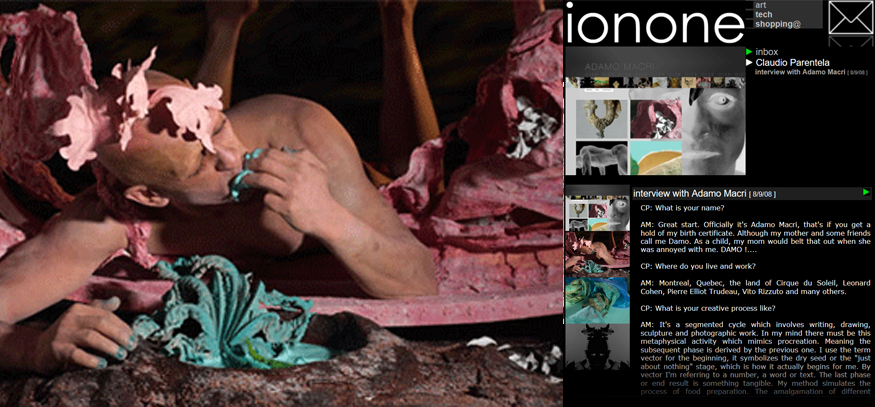
CP: What is your name?
AM: Great start. Officially it's Adamo Macri, that's if you get a hold of my birth certificate. Although my mother and some friends call me Damo. As a child, my mom would belt that out when she was annoyed with me. DAMO !....
CP: Where do you live and work?
AM: Montreal, Quebec, the land of Cirque du Soleil, Leonard Cohen, Pierre Elliot Trudeau, Vito Rizzuto and many others.
CP: What is your creative process like?
AM: It's a segmented cycle which involves writing, drawing, sculpture and photographic work. In my mind there must be this metaphysical activity which mimics procreation. Meaning the subsequent phase is derived by the previous one. I use the term vector for the beginning, it symbolizes the dry seed or the "just about nothing" stage, which is how it actually begins for me. By vector I'm referring to a number, a word or text. The last phase or end result is something tangible. My method simulates the process of food preparation. The amalgamation of different elements to arrive at a specific feeling or flavor.
CP: What is your favorite medium?
AM: I don't have a favorite. They're tools in a methodical process. It always begins with writing a word or phrase down based on an idea. Then I begin sketching. Passed that point I think sculptural and objects have to be created. Finally, the 3D work needs to be recorded and documented by means of a camera. The camera literally becomes a weapon, the weapon used to eliminate sculpture. Going back to your question, I use more than one medium, as many artists do. I'm most comfortable with being described as a multimedia artist, if the term artist doesn't suffice.
CP: The sculptural work you create must die?
AM: Figuratively speaking. Yes, it begins with a seed and it ends up getting "shot". It's full circle. My concept with the tangible object, "sculpture" is what I refer to as a 3D Event, the practice of anti-sculpture. It's about perceiving sculpture as occurrence and not static presence. Ironically it ends up being sculptural because the final is an installation piece, but the sculptural aspects are trapped within. The photographic segment places all objects in the past tense. In an instant, sculpture has vanished and a new reality is created. The same thing happened to my grandmother and now we have to resort to our photo album to see her. For me the resonating image is of utmost importance.
CP: What is your current favorite subject?
AM: It's been the same for many years and probably forever. Human nature and condition, sexuality, contamination and cultural identity, minced and fused together. These are my set commandments. Currently, I've got my Antipasto project which will be ongoing due to its scope. This project's mandate involves creating a trajectory between two iconic works, Andy Warhol's Electric Chair and Da Vinci's Last Supper. Briefly, it requires celebrity participation, in which they're asked to disclose their final meal. One of the challenges is to generate an image based on what they consume and not their physical being. I'm excited about this approach to portraiture. Food as intimate subject matter. I'm overwhelmed by the response of the many artists who've contributed to date. Another project I'm developing is Silicon 1972.5 which documents the films created by both Federico Fellini and Pier Paolo Pasolini between 1969 and 1976. The objective here is a meditation into the collective subconscious, by channeling the films and their associative subject matter.
CP: Which artists have contributed to the Antipasto project and how many do you plan to involve?
AM: I refer to each reply received as an "order". I've received orders from John Baldessari, Karim Rashid, John Gilmore, H.R. Giger, Loretta Lux, Henry Rollins, Raine Maida, Fischerspooner, Floria Sigismondi, Edward Ruscha, Barry Gifford, Franko B, Herschell Gordon Lewis, David LaChapelle and many more. As far as the amount, I'd like a figure that symbolizes 100% split into two equal halves. Meaning, two large clusters. Each one representing and functioning as a cell. That's 2 cells of 50 which totals 100.
CP: How long does it take for you to finish a piece?
AM: Usually a long time. Painters have it easy that way, they need paint and a canvas, in little time they've got a finished piece. It doesn't happen that way for me. I've got project sketches from the mid eighties which would love to see the light of day. I guess funding would speed-up the cause. Actually I take back what I said - countless paintings took many years to complete.
CP: What has been your biggest accomplishment so far?
AM: I'm not one who lives in the past. I can't and don't think that way. Everything I've done in my life has value, even the bad stuff. My answer is, what I'm working on at the moment. That excites me the most, you know... the next thing.
CP: Are there any contemporary artists that you love?
AM: Many - they're all great in my book, alive, buried or buried alive. It's a natural attraction, a kinship I suppose. Recently I was fascinated by Vanessa Beecroft's South Sudan project. I'm always eager to see Damien Hirst, Ron Mueck and Paul McCarthy's work. There are many.
CP: Can we buy your art anywhere?
AM: No, but you can contact my studio for information.
CP: Anything that people should know about that we don’t?
AM: Yes... lots, maybe too much. But I always say, don't spill your beans at once. Expose one at a time and make each as enticing as possible. Alright, I'll go out on a limb and say... I do love just about everything in nature except three things, which coincidentally rhyme - cats, bats and rats.
CP: What is your best piece of advice for those who would like to rise in their level of artistry?
AM: That would be: Determine what you're about. Find the best medium and technique to communicate what that is. Remain focussed, honest and stick to your guns. This may sound typical but it's the only way.
CP: What inspires you to keep going when the work gets frustrating or tough?
AM: Getting frustrated with what you're involved with, only means that you've been doing something wrong. Either working long hours or the project wasn't managed properly. But figuring out what doesn't work is part of the process. It should be addressed, then rectified or deleted. At times I struggle to find the missing link. It's frustrating, you're caught up in the moment, things aren't fitting properly. I believe it's time for a break. Leaving that environment works. Reinitialize... things will follow better later.
CP: How do you describe your work to those who are unfamiliar with it?
AM: I don't or as little as possible. I'd say that it's abstract. I'll talk about general subject matter and advise them to investigate other works which would help with what they're inquiring about. An artist shouldn't dictate his work. It's damaging to those who have a completely different perception. That goes against everything I'm about, which is variables, individualism and ambiguity. The title of the piece isn't ancillary, it's the best indicator of which direction to go. I believe that the art ornaments the title and not the other way around. There are many variables which would work as imagery but only one title.
CP: What kind of training did you have which helped you achieve your current level of artistry?
AM: Life experience mainly, tagged with my education in fine art, history and graphic design. You can have all the training you want from whichever reputable institution, but art comes from somewhere incomprehensible, from a very early stage in life.
CP: Is there a tool or material that you can’t imagine living without?
AM: Yes, styrofoam. It's solid yet weightless, it's dry but can become organic, seems innocent but it's toxic, can be beautiful but escentially fake, is somewhat dumb and yet I can go on forever about it. Actually I'm very close to completing a new project called Endocrine Disruptor, where styrofoam takes the lead role.
CP: Who are your influences?
AM: Other than family, friends and environment, a handful of artists have inevitably inspired me. The prominent ones would be Salvador Dali, David Lynch, Federico Fellini, Andy Warhol, Peter Greenaway, David Bowie and Alejandro Jodorowsky.
CP: What inspires you to create?
AM: Everything and nothing. It just happens. I don't have a handle on it. It's taxing at times, many artists feel this way, it's very close to being possessed. I've always joked about reincarnation and that if it exists, I'd want to come back as a "normal boy" and have the need to play golf.
CP: Your contacts
AM: Adamo Macri Studio: 514-937-9786 or info@adamomacri.com. I'd like to end with this. "The most beautiful thing we can experience is the mysterious. It is the source of all true art and all science. He to whom this emotion is a stranger, who can no longer pause to wonder and stand rapt in awe, is as good as dead. His eyes are closed." Albert Einstein.
Links and References:
www.adamomacri.com
www.adamomacri.blogspot.com
cparentela.livejournal.com/9677.html
From: Kirk Leslee. Date: August 26, 2008
Interesting concepts.
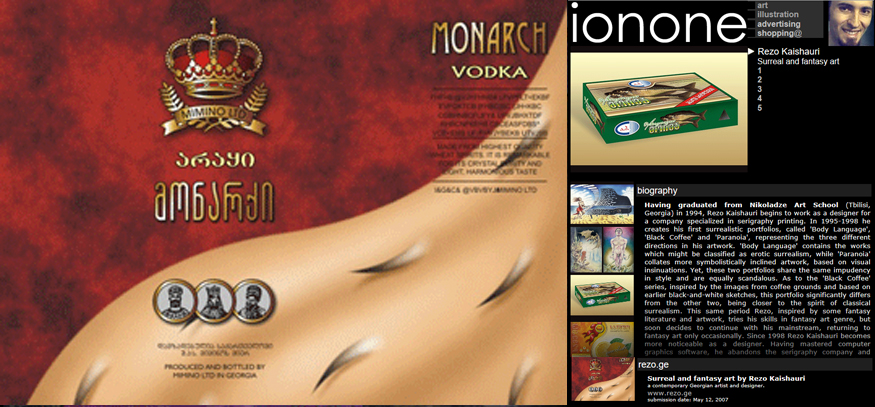
"Surrealism is not the way you live, act or feel. It's the way you dream. We, who call ourselves 'surrealists', are marked by the Lord himself with a slightest touch of insanity. Creative insanity that is, granting the freedom to transform reality, to reach beyond visible, and to display the possibility of impossible. My personal goal, as a surrealist, is to represent the unreality with maximum reality, trying to make you believe in what you see. This is what Salvador Dali did the best." -- Rezo Kaishauri
Having graduated from Nikoladze Art School (Tbilisi, Georgia) in 1994, Rezo Kaishauri begins to work as a designer for a company specialized in serigraphy printing. In 1995-1998 he creates his first surrealistic portfolios, called 'Body Language', 'Black Coffee' and 'Paranoia', representing the three different directions in his artwork. 'Body Language' contains the works which might be classified as erotic surrealism, while 'Paranoia' collates more symbolistically inclined artwork, based on visual insinuations. Yet, these two portfolios share the same impudency in style and are equally scandalous. As to the 'Black Coffee' series, inspired by the images from coffee grounds and based on earlier black-and-white sketches, this portfolio significantly differs from the other two, being closer to the spirit of classical surrealism. This same period Rezo, inspired by some fantasy literature and artwork, tries his skills in fantasy art genre, but soon decides to continue with his mainstream, returning to fantasy art only occasionally. Since 1998 Rezo Kaishauri becomes more noticeable as a designer. Having mastered computer graphics software, he abandons the serigraphy company and turns to offset printing. Trying several different advertising agencies and printing companies, finally he determines as an independent designer. Since 2000 he gradually widens the field of his activity and the range of customers, becoming a color separation specialist and trying skills as a web-designer. Presently Rezo tries to maintain the balance, continuing with his design work, but still finding some time to draw pictures despite his crowded schedule. He has many plans and projects for the future, so both sections of this website will be constantly updated with new works.
read more »
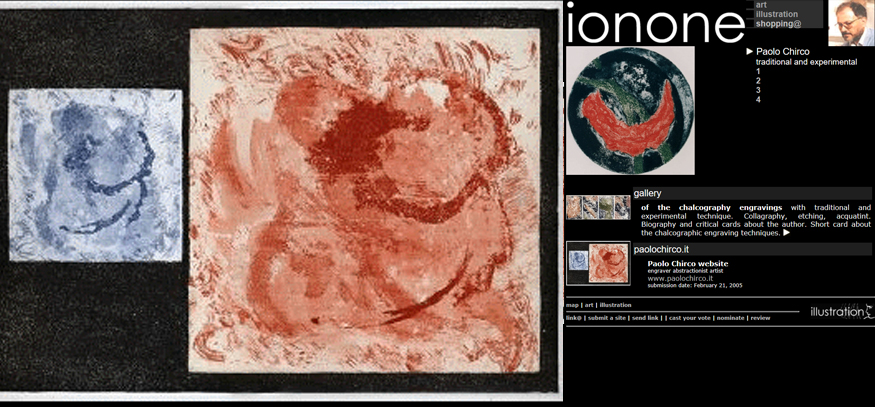
Gallery of the chalcography engravings with traditional and experimental technique. Collagraphy, etching, acquatint. Biography and critical cards about the author. Short card about the chalcographic engraving techniques. read more »
www.paolochirco.it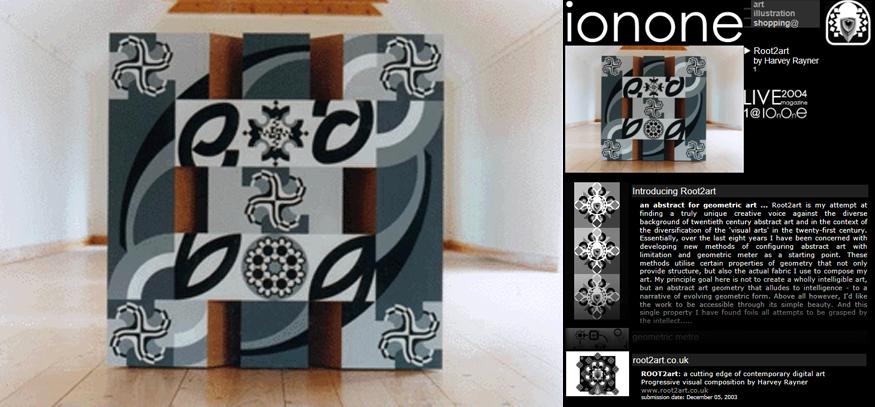
an abstract for geometric art ... Root2art is my attempt at finding a truly unique creative voice against the diverse background of twentieth century abstract art and in the context of the diversification of the 'visual arts' in the twenty-first century. Essentially, over the last eight years I have been concerned with developing new methods of configuring abstract art with limitation and geometric meter as a starting point. These methods utilise certain properties of geometry that not only provide structure, but also the actual fabric I use to compose my art. My principle goal here is not to create a wholly intelligible art, but an abstract art geometry that alludes to intelligence - to a narrative of evolving geometric form. Above all however, I'd like the work to be accessible through its simple beauty. And this single property I have found foils all attempts to be grasped by the intellect.....
I describe my work as being created in and derived from a unique system of geometric metre. This is the metre of visual composition as opposed to the metre found in poetry although the formalising and ordering property is the same. This metre, derived from particular and distinct geometry, provides a grammar and the fabric of my visual language.
I liken this system to the structural conventions evolved and adhered to in musical composition. These conventions limit, define and order an abstract sound world into the stuff of musical language. As with some musical language my visual language is shaped by the concerns of harmony, dynamics, rhythm, lyricism and counterpoint. I find music, and musical terminology an invaluable resource in describing my work and finding tangible ideas for invention within visual composition.
read more »
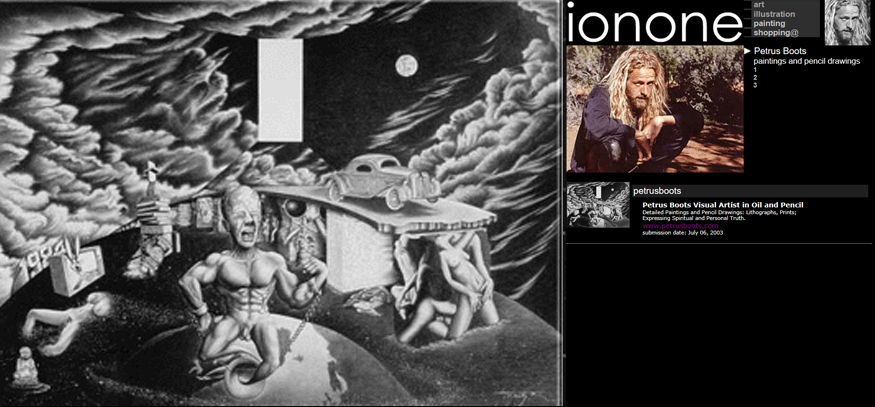
Detailed Paintings and Pencil Drawings: Lithographs, Prints; Expressing Spiritual and Personal Truth. read more »
www.petrusboots.com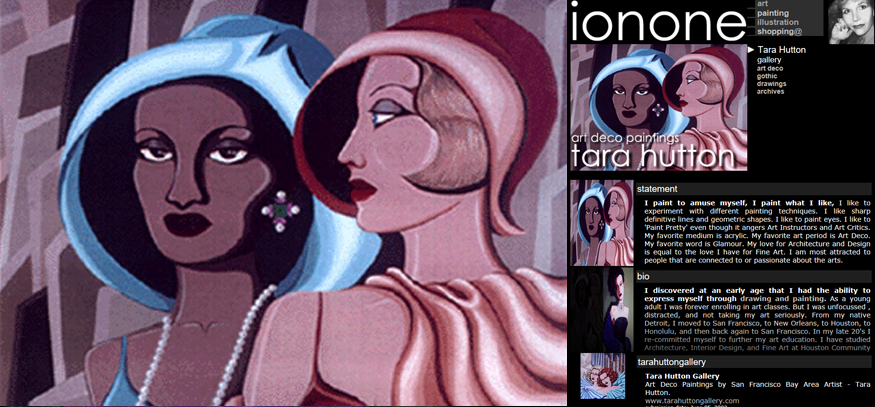
I paint to amuse myself, I paint what I like, I like to experiment with different painting techniques. I like sharp definitive lines and geometric shapes. I like to paint eyes. I like to 'Paint Pretty' even though it angers Art Instructors and Art Critics. My favorite medium is acrylic. My favorite art period is Art Deco. My favorite word is Glamour. My love for Architecture and Design is equal to the love I have for Fine Art. I am most attracted to people that are connected to or passionate about the arts.
I discovered at an early age that I had the ability to express myself through drawing and painting. As a young adult I was forever enrolling in art classes. But I was unfocussed , distracted, and not taking my art seriously. From my native Detroit, I moved to San Francisco, to New Orleans, to Houston, to Honolulu, and then back again to San Francisco. In my late 20's I re-committed myself to further my art education. I have studied Architecture, Interior Design, and Fine Art at Houston Community College in Texas and also at the College of Marin in California. It was at the College of Marin that I took my first figurative painting class and I heard my calling, I have been at the easel ever since.
read more »
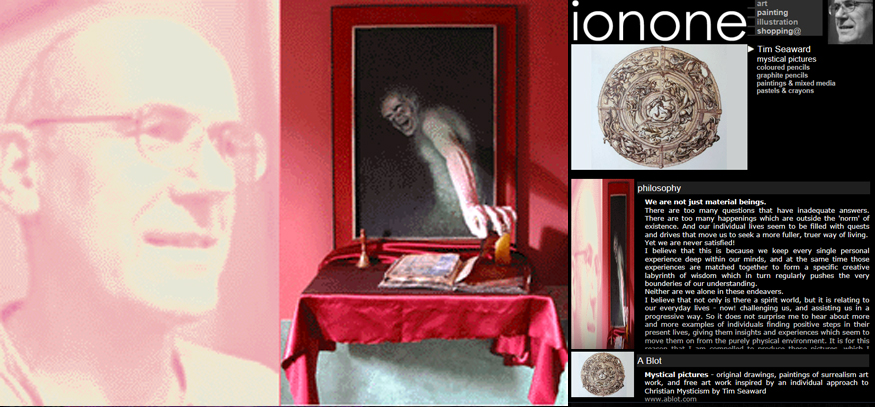
We are not just material beings. There are too many questions that have inadequate answers. There are too many happenings which are outside the 'norm' of existence. And our individual lives seem to be filled with quests and drives that move us to seek a more fuller, truer way of living. Yet we are never satisfied! I believe that this is because we keep every single personal experience deep within our minds, and at the same time those experiences are matched together to form a specific creative labyrinth of wisdom which in turn regularly pushes the very bounderies of our understanding. Neither are we alone in these endeavers. I believe that not only is there a spirit world, but it is relating to our everyday lives - now! challenging us, and assisting us in a progressive way. So it does not surprise me to hear about more and more examples of individuals finding positive steps in their present lives, giving them insights and experiences which seem to move them on from the purely physical environment. It is for this reason that I am compelled to produce these pictures, which I believe are simple but relevant aids to be observed and remembered. More specifically, I feel that once the picture is seen, then the mind stores the image - permanently. The visual, being an indelible element, will be unravelled at the appropriate time. I liken this 'process' to the ancient form of chemistry - Alchemy, inwhich the alchemist was driven by the thought that gold could be made from base metals and that there was a material called the philosophers stone which was a vital ingredient to producing the elixir of life. These pictures are my attempt at being a metaphoric alchemist! read more »
www.ablot.com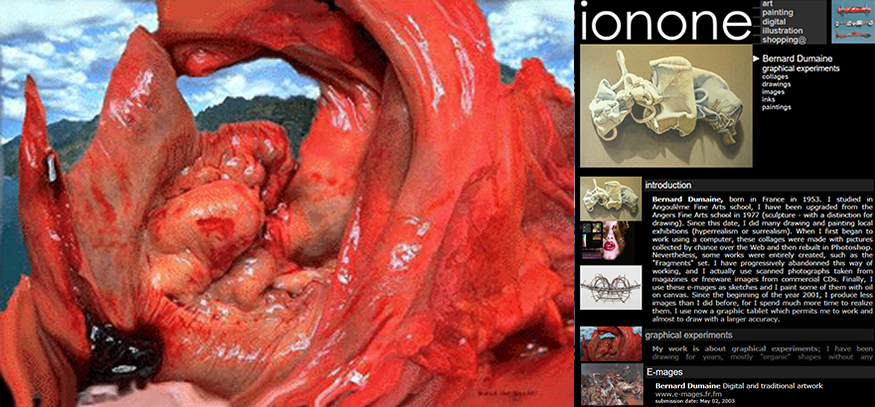
Bernard Dumaine, born in France in 1953. I studied in Angoulême Fine Arts school, I have been upgraded from the Angers Fine Arts school in 1977 (sculpture - with a distinction for drawing). Since this date, I did many drawing and painting local exhibitions (hyperrealism or surrealism). When I first began to work using a computer, these collages were made with pictures collected by chance over the Web and then rebuilt in Photoshop. Nevertheless, some works were entirely created, such as the "Fragments" set. I have progressively abandonned this way of working, and I actually use scanned photographs taken from magazines or freeware images from commercial CDs. Finally, I use these e-mages as sketches and I paint some of them with oil on canvas. Since the beginning of the year 2001, I produce less images than I did before, for I spend much more time to realize them. I use now a graphic tablet which permits me to work and almost to draw with a larger accuracy.
My work is about graphical experiments; I have been drawing for years, mostly "organic" shapes without any preliminary plan. Actually, I create pictures using Photoshop and I sometime use them as sketches to paint
www.e-mages.fr.fm
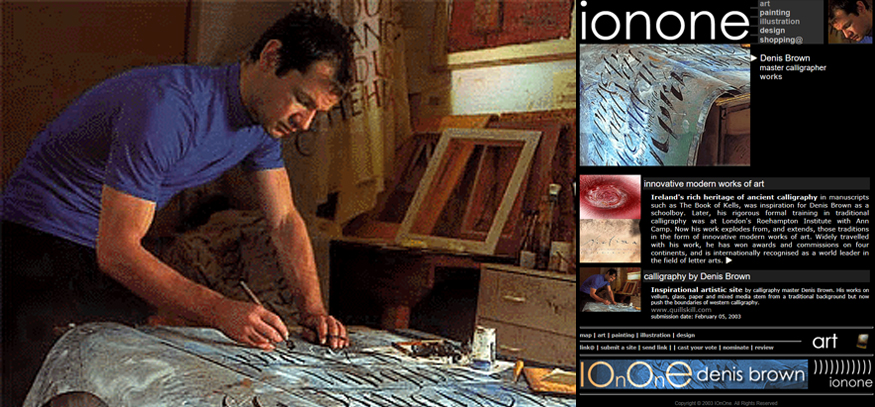
Ireland's rich heritage of ancient calligraphy in manuscripts such as The Book of Kells, was inspiration for Denis Brown as a schoolboy. Later, his rigorous formal training in traditional calligraphy was at London's Roehampton Institute with Ann Camp. Now his work explodes from, and extends, those traditions in the form of innovative modern works of art. Widely travelled with his work, he has won awards and commissions on four continents, and is internationally recognised as a world leader in the field of letter arts. read more »
www.quillskill.com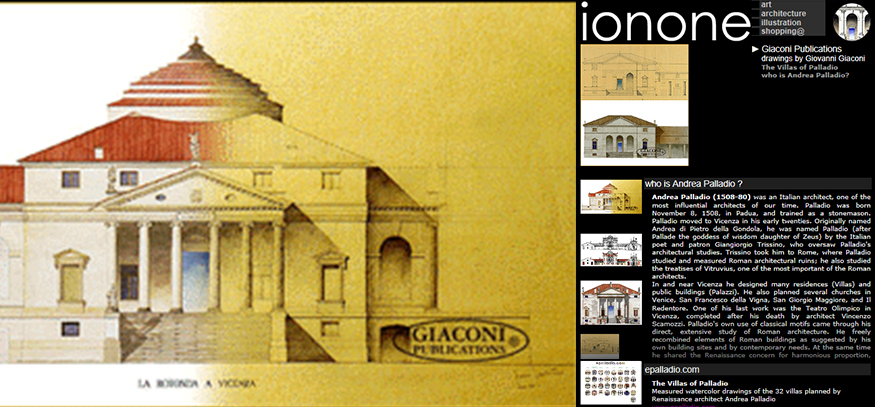
Andrea Palladio (1508-80) was an Italian architect, one of the most influential architects of our time. Palladio was born November 8, 1508, in Padua, and trained as a stonemason. Palladio moved to Vicenza in his early twenties. Originally named Andrea di Pietro della Gondola, he was named Palladio (after Pallade the goddess of wisdom daughter of Zeus) by the Italian poet and patron Giangiorgio Trissino, who oversaw Palladio's architectural studies. Trissino took him to Rome, where Palladio studied and measured Roman architectural ruins; he also studied the treatises of Vitruvius, one of the most important of the Roman architects. In and near Vicenza he designed many residences (Villas) and public buildings (Palazzi). He also planned several churches in Venice, San Francesco della Vigna, San Giorgio Maggiore, and Il Redentore. One of his last work was the Teatro Olimpico in Vicenza, completed after his death by architect Vincenzo Scamozzi. Palladio's own use of classical motifs came through his direct, extensive study of Roman architecture. He freely recombined elements of Roman buildings as suggested by his own building sites and by contemporary needs. At the same time he shared the Renaissance concern for harmonious proportion, and his facades have a noteworthy simplicity, austerity and repose. Palladio was the first architect to develop a systematic organization of the rooms in a house. He was also the first to apply to houses the pedimented porticos of Roman temples-formal porches defined by a shallow triangular gable (Timpano) supported by a row of columns. Both these features are exemplified in the Villa Almerico "The Rotonda". Palladio's buildings were highly functional. Palladio was the author of an important scientific treatise on architecture, I Quattro Libri dell'Architettura (The Four Books of Architecture), which was widely translated and influenced many later architects. Its precise rules and formulas were widely utilized, especially in England, and were basic to the Palladian style, adopted by Inigo Jones, Christopher Wren, and other English architects, which preceded and influenced the neoclassical architecture of the Georgian Style. Palladio married Allegradonna, daugther of Marcantonio, and had five children, Leonida, Marcantonio, Orazio, Silla and Zenobia. He died on August 19, 1580 in Vicenza, or probably at Maser (Treviso), while attending construction of the Tempietto of Villa Barbaro. read more »
www.epalladio.com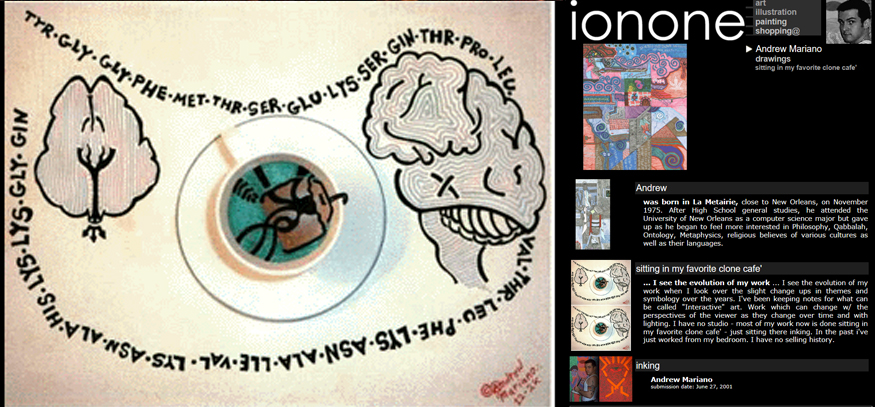
... I see the evolution of my work ... I see the evolution of my work when I look over the slight change ups in themes and symbology over the years. I've been keeping notes for what can be called "Interactive" art. Work which can change w/ the perspectives of the viewer as they change over time and with lighting. I have no studio - most of my work now is done sitting in my favorite clone cafe' - just sitting there inking. In the past i've just worked from my bedroom. I have no selling history.
Andrew was born in La Metairie, close to New Orleans, on November 1975. After High School general studies, he attended the University of New Orleans as a computer science major but gave up as he began to feel more interested in Philosophy, Qabbalah, Ontology, Metaphysics, religious believes of various cultures as well as their languages
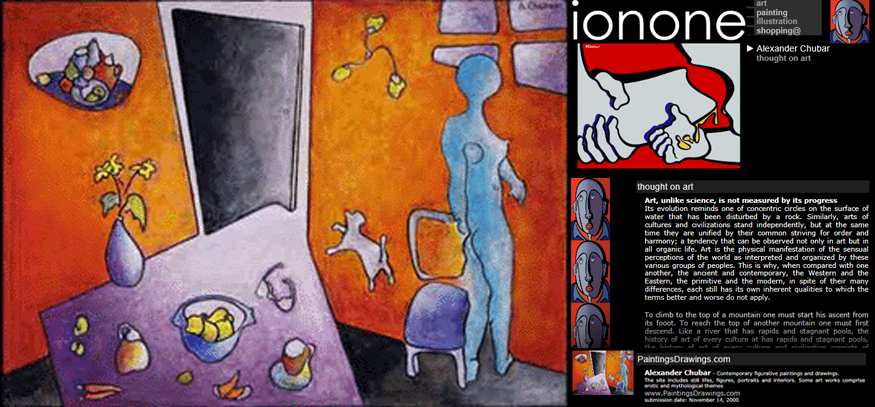
Art, unlike science, is not measured by its progress.
Its evolution reminds one of concentric circles on the surface of water that has been disturbed by a rock. Similarly, arts of cultures and civilizations stand independently, but at the same time they are unified by their common striving for order and harmony; a tendency that can be observed not only in art but in all organic life. Art is the physical manifestation of the sensual perceptions of the world as interpreted and organized by these various groups of peoples. This is why, when compared with one another, the ancient and contemporary, the Western and the Eastern, the primitive and the modern, in spite of their many differences, each still has its own inherent qualities to which the terms better and worse do not apply.
To climb to the top of a mountain one must start his ascent from its fooot. To reach the top of another mountain one must first descend. Like a river that has rapids and stagnant pools, the history of art of every culture at has rapids and stagnant pools, the history of art of every culture and civilization consists of periods of renaissance alternated with periods of decline. For instance the first half of the twentieth century was marked by an unprecedented upsurge in the evolution of art. Then followed a period of absorption and transformation of the previous achievements on the one hand, and their total neglect and denial on the other. it is sad, but this latter current dominates in the art world today. The goal of making money prevails over the goal of making art. The importance of an art object is reduced to a minimum with the emphasis given to the spectator's perception.
Therefore an art object plays the role of a stimulus which takes its final form in the specta There is also a tendency in contemporary art toward the merging of various heterogeneous elements of styles of the past with no attempt at correlation between these elements or submiithese elements or submiandards of art to the level of comprehension of the man on the street. "Painting is a thing of intelligence" Picasso once said, meaning that its understanding requires some knowledge and ability to understand. The only art is that which serves itself; the ssion of them to the wholeness of the composition. Such a work becomes a tangle of contradictions, where disorder serves no purpose except to shock the viewer. Thus many so called artists paint eclectic works in which they are guided not by any degree of purposefulness, but rather merely by chance. Synthesis, not eclecticism, should be the goal of a thinking artist whose every detail should exist and function in harmonious union with the whole. There is also the tendency toward lowering the sttttrest is only a surrogate. A work of art contains its own intrinsic qualities which possess certain meaning and purpose.
Art functons as a mirror where the conscience of each generation is reflected in a concrete form. At present, we look at some of the reions as a mirror where the conscience of each generation is reflected in a concrete form. At the present we look at some of the refll ections with fear and repulsion, like Pasiphae at her hideous fruit of love. However, in opposition to the artistically weak and morbid creations, the principles of the other current are based on the inner structure of an art work and the cohesion of its elements that function as a whole. In this case, a work of art carries a perceptually self evident expression which a spectator does not convert into expressive and harmonious images in his mind, thus completing it; but is instead an independent entity.
The goal of evolution is improvement. Only the finest can survive this battle; an eternal battle which takes place among the representatives of each generation. The rest settle, after a time, to the bottom like det and sink into oblivion. Like all living thientatives of each generation. The rest settle, after a time, to the bottom like detritus, and sink into oblivion. Like all living thing s, an artist has a purpose. One of the meanings of his life consists of the development of his talent like a seed's purpose is to become a flower. To find his purpose in life an artist must uncover his potential. To make his life meaningful, he must fulfill that potential. The objective of a true artist is the development of a specific artistic system. He is similar to a criminal, who does not obey the old rules, but breaks them, creating hh hl, who does not -obey the old rules, but breaks them, creating his own and revealing his ego. A creator is duty bound to rethink everything with honesty, talent and ambition, creating images which correspond to his conception of reality.
When an artist paints, he does not imitate reality, but creates a new one, based on its own laws and its own principles. Also, the aim of art is not to represent the inward significance of things, but to represent the inward significance of the artist through the inward significance of the objects he paints. In the course of his work an artist relies on his intuition, knowledge and skill. With the aid of these he expresses his own conception of the ultimate reality, bringing it to perceptual level. Philosophy is the foundation on which the building of art is erected. Thus a work of art is a representation of a philosophy in a concrete form.
As snow is the crystallization of water, an art work is the crystallization of the artist's feeling; a feeling that is captured in a cage of colors and lines, in the case of painting, or by other means in other art mediums. The radiance that emanates from a work of art takes as its source that caged feeling. Like the rays of light or waves of sound which we perceive with the help of our eyes and ears, we sense this radiance through our minds and souls. It vibrates, moving and touching our senses, giving us intellectual pleasure. A true work of art is a creation of a mind for a mind. It is a harmony of symbols, which is itself a symbol.
After its completion, an art work becomes free of itits creator. It does not depend on the spectator's perception. It lives its own independent life according to its own laws, laws upon which its unity is built. In short, a work of art is an entity by itself that relies on its own qualities.
Alexander Chubar
www.PaintingsDrawings.com